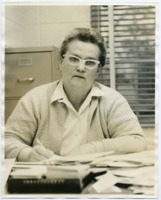
Browse Items (2060 total)
Sort by:
-
Abbreviated timeline of the Apollo 11 mission.
The timeline includes a memorandum from Friedjof A. Speer, manager of the Missions Operations Office, to employees of Marshall Space Flight Center. Speer notes that "astronaut Neil Armstrong is scheduled to be the first man to step onto the moon's surface." The timeline outlines the entire mission from liftoff at 8:32 AM on Wednesday, July 16, 1969 to splashdown at 11:49 AM on Thursday, July 24, 1969. -
Letter from Col. John C. Nickerson at Redstone Arsenal in Huntsville, Alabama, to Gen. James A. Pickering in Atlanta, Georgia.
In this letter, Nickerson thanks Gen. Pickering for his support and explains why he believes the Army is the best service branch to develop ballistic missiles. He also discusses the need for missiles in case of war with the Soviet Union. Nickerson was a staff officer at the Army Ballistic Missile Agency at Redstone Arsenal assigned to work on the Jupiter, the United States' first mid-range ballistic missile. He was arrested and court martialed for espionage in 1957 after releasing sensitive documents about the United States missile program to the press. At the time, Secretary of Defense Charles E. Wilson granted the Air Force sole authority to develop intermediate range ballistic missile systems. Nickerson disagreed with this policy, and in response, leaked documents that demonstrated the superiority of Army missiles compared to those developed by the Air Force. He eventually pled guilty to lesser charges and was suspended from the Army for one year and was fined $1,500. Dr. Wernher von Braun was among those who testified on Nickerson's behalf. -
Photo of Frances C. Roberts.
Photo from the Huntsville Times. The photo was taken for an article about the honorary doctor of humane letters that Roberts received from UAH on December 12, 1993. -
Drawings of a sidewalk well and rail on Courthouse Square in downtown Huntsville, Alabama.
The drawings include plans for a building a well in the sidewalk with a glass top for viewing the "old handmade brick walk" underneath the current sidewalk. In one of the notes, architect Harvie P. Jones notes that the historic sidewalk probably dates from the early to mid-nineteenth century "based on its depth of approximately 10" below the present walk." The well is located in front of 205 East Side Square. It was restored in 2018. -
Letter from Sen. Lister Hill, Sen. John Sparkman, and Rep. Bob Jones to Huntsville radio stations.
Addressed to stations WBHP and WFUN, the letter announces that the U. S. Senate passed "legislation authorizing construction work for Redstone Arsenal totaling $4,250,000." The letter also mentions building rocket test stations and a flight test range. -
Photo album of downtown Huntsville from the city's sesquicentennial celebration.
The album includes photos of the Confederate monument and banners and decorations on the street.









